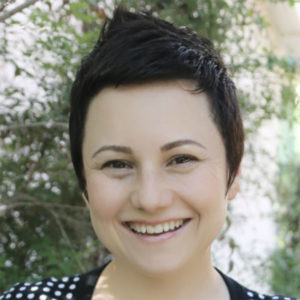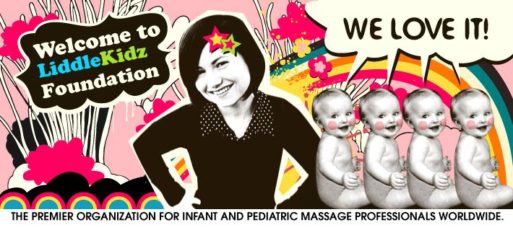Today SevenPonds speaks with Tina Allen, the founder and director of Liddle Kidz™ Foundation, an organization that provides education and outreach in the areas of children’s health and nurturing touch. A recognized leader in the field of pediatric massage therapy, Ms. Allen brings a wealth of knowledge and experience to her work with children and families all over the world. She has worked to create pediatric massage programs in several major medical centers throughout the United States, including Mayo Clinic and Children’s Hospital Los Angeles, and is the author of the award-winning book, “A Modern Day Guide to Massage for Children.” She also leads a pioneering effort to bring nurturing touch to children in orphanages across the globe.

Tina Allen
Kathleen: Thanks so much for taking the time to speak with me, Tina. I know how busy you are, so I’ll dive right in. Can you tell me a little bit about your role as director of Liddle Kidz Foundation?
Tina Allen: As both the founder and director of Liddle Kidz Foundation, my role is very diverse. For example, I oversee employees and pediatric massage program development for hospitals and healthcare systems all over the world. I also develop much of the curriculum for our programs, and provide in-person education in infant and pediatric massage therapy for hospital and healthcare staff.
I stay actively involved in the day-to-day operations of Liddle Kidz in order to ensure the important mission and vision of the organization continues as I started it. We are expanding our services into healthcare and hospital settings at a rapid pace, implementing our programs in at least one or two new countries every year.
Kathleen: How did you become involved in pediatric massage therapy?
Tina: When I began my education, I didn’t intend to become a massage therapist. I majored in pediatric occupational therapy. I knew that I wanted to work with children in a health care capacity, but I had no interest in “poking and prodding” them. During the OT program, I discovered I would not learn very much about the use of integrative therapies. So I decided to seek out more education. That’s when I entered a massage program with the goal of adding massage therapy as an adjunct to my work as a pediatric OT.
As I pursued my studies in both disciplines, I soon learned that educators never discussed children when they talked about massage. It was at that moment that my interest in infant and pediatric massage was born.

Tina provides massage therapy to a hospitalized child
Kathleen: I understand that you worked with HIV/AIDS patients back in the 1990s, when AIDS was still a major cause of death in the U.S. What was it like working with this population?
Tina: Working with these individuals was a great opportunity to provide massage therapy for those who would benefit most from touch.
At the time, there was significant stigma associated with a diagnosis of HIV/AIDS. Hands-on care providers took enormous precautions, as many believed you could contract the disease via touch. Patients were looked upon by many as “untouchable.” They were isolated and alone. Even parents felt uncomfortable touching their children if the child had AIDS, even when they had HIV themselves. There was so much fear around contracting the virus.
In my experience, giving touch therapy to people with HIV/AIDS provided not only the physical benefits we assume take place with the use of massage, but also the simple act of being touched without fear. The enormous emotional benefits this provided was beyond compare.
I remember one of my clients stating that he thought of me as his “window on the world.” He was a client that was non-ambulatory and had an AIDS diagnosis. It was difficult for him to even see out the window, and part of our session time included my talking to him about what I saw outside.
Kathleen: How did you begin to expand your pediatric massage program into hospitals? I imagine it isn’t easy to get your foot in the door.
Tina: No it is not! There is a lack of basic knowledge of the benefits of massage therapy, especially for children. In healthcare settings, specifically hospitals, I come across doctors and nurses who have no understanding of what massage therapy can do. They actually minimize its potential as a part of a comprehensive plan of care for pediatric patients.
When I come across this resistance, I find myself providing basic information. For instance, I educate them in the differences between massage in the spa setting versus massage in the hospital. I’ve made it my life’s goal to educate on the benefits of pediatric massage.
In working to establish a pediatric massage program, we need at least one staff member who becomes a champion. This person is the contact who aids us in presenting the program to administrative leaders, physician groups and nursing staff. Their help is key to implementing a program successfully.

Credit: Little Kids Foundation.org
Kathleen: What type of massage is appropriate for hospitalized children, and what do you see as the primary benefit?
Tina: Children with chronic conditions or complex medical needs often develop fear and anxiety surrounding their medical care. They must cope with a variety of stressors, symptoms and side effects related to their illness and treatment. Facilitating healthy touch experiences within the medical system can help to restore trust. It also teaches children how to express their needs and generally improves their quality of life.
Pediatric massage is appropriate for almost any child in the hospital setting. For example, we use it for children who have heart conditions and cancer and kids in intensive care. It is also very useful in the palliative care setting, helping children at the end of life. Even very ill children appear to have less stress and anxiety, more energy and less pain after massage. Massage can also relieve constipation. That’s often an issue for children who are unable to get out of bed and move around or are on certain medications.
Want to see pediatric massage in action? Check out Tina’s video demonstrating seated massage here. And please come back next week for the second part of our interview to learn more about pediatric massage!

 What Is Pediatric Massage Therapy? An Interview with Tina Allen: Part One
What Is Pediatric Massage Therapy? An Interview with Tina Allen: Part One


 Forest Bathing Eases Grief by Soaking in Nature
Forest Bathing Eases Grief by Soaking in Nature
 The Spiritual Symbolism of Cardinals
The Spiritual Symbolism of Cardinals















